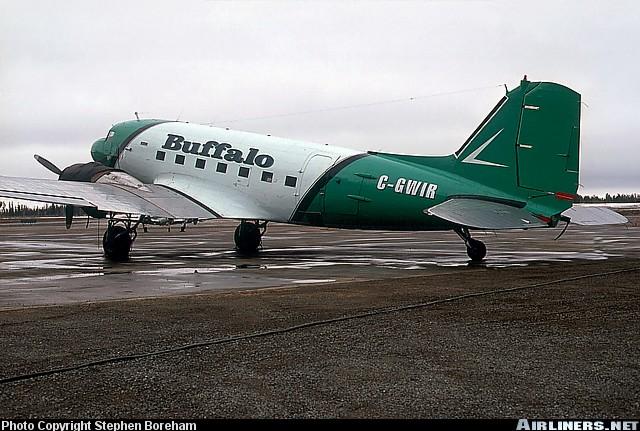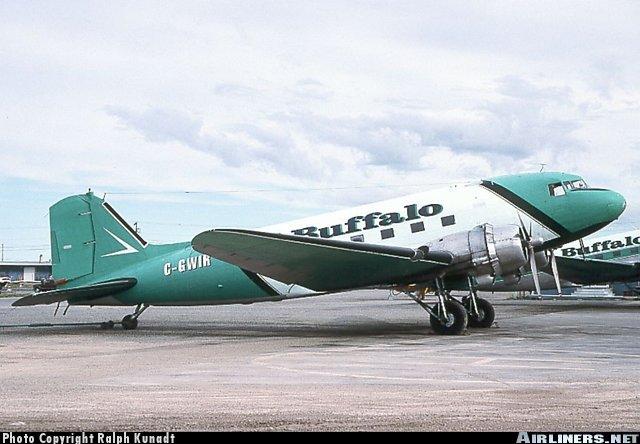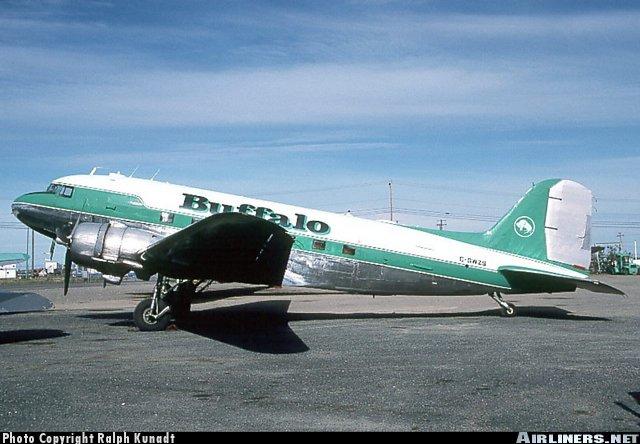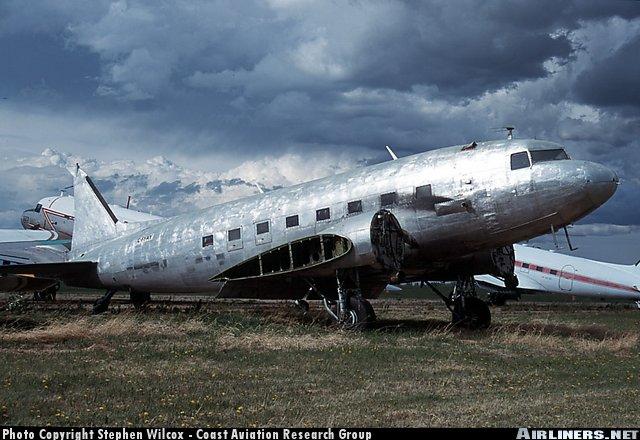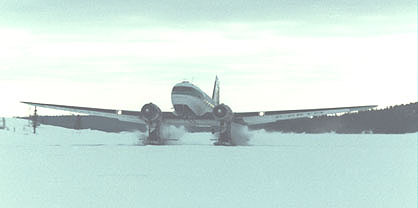
Story from an ex-Buffalo Airways Pilot... Jock McCann
In looking through my flying log, I note one remarkable week of DC-3 "operations" during the summer of 1994, where we were called in to evacuate all of the residents of the native settlement of "Trout Lake", due to an approaching out-of-control wild fire that NWT Forrestry was battling in the vicinity. We "based" out of Fort Simpson Airport, which simply has to be seen to be believed for its simplistic beauty, during high summer in the Territories. Hundreds of Cranes occupy the grass expanse that borders the main runway at Simpson, without appearing to notice the throaty growl of a departing DC-3. In the week from July 31 to the 3rd of August, we had been "tasked" by Forrestry to fly drums of "Jet B" to Trout Lake airstrip (45 minutes to the south of Fort Simpson), after the village evacuation had been completed. In temperatures of one hundred degrees OAT, and in daylight that extended to midnight, we flew trip after trip, sixteen drums in each 45-minute haul to Trout Lake, to resupply the Helicopter crews battling an expansive forest fire. On each trip in and out of the Trout Lake area we went to "Forrestry Frequency" on the VHF...we had to fly a specific "in and out" corridor to miss the Bombers (Tracker aircraft from BC's "Conair" company, as well as Canadair CL-215's operating in the area) doing their "bit" to save a few thousand acres of northern woodland from going up in smoke.

Our Captain was Graham Thoburn, who hailed from Vancouver and was the son of Terry Thoburn, an RCAF "Jet-Jock" who (in 1994) was a Captain on a Canadian DC-10, on the Japan route. Initially, our First Officer was Andrew Dzall, from Poland, and then on the third day of our "drum haul" flights, Andrew was "spelled off" by Kenny Bews, whose father had flown DC-3's with our owner, "Buffalo Joe" McBryan, in the days of the Northwest Territorial Airways being a major carrier in the NWT. As I had been sent along on the evacuation of Trout Lake to fly as "Biscuit-shooter", I remained as part of the crew to assist in loading (and unloading) the aircraft, and spell-off the Captain or First Officer, enroute to and from Trout Lake. We loaded our own aircraft (naturally!), and at the "unloading end", we had a unique method of "dumping" sixteen drums out the back of the DC-3 in under three minutes. We carried three old 15" car tires, which we would "stack" under the cargo door of the aircraft, after engine "shut-down".
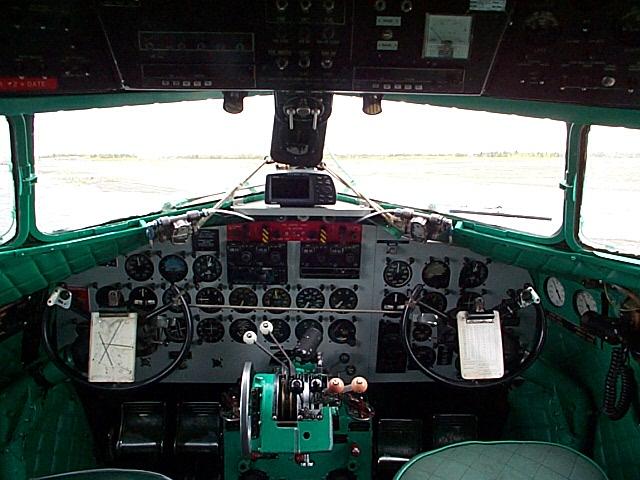
As the Captain unbuckled the herc-straps that secured the drums to the deck of the aircraft, another of our number would "lay" the drum down and allow the drum to (slowly) roll to the open door, where the third member would "spin" the drum and roll it out the door, "bouncing" it onto the tires. Thereby, the drum would "bounce" and roll away from the aircraft undamaged. In minutes, the DC-3 was empty; we would back-haul empty drums to Simpson, if they were available...but in as little as five minutes, the Captain was starting the number two engine (the cable to the nose-mounted batteries is shorter from the number two, than it is from the number one, ergo, more "juice" delivered on start-up to the right engine) the First Officer was pulling the "gear-pins" while the "Biscuit shooter" was pulling the rudder lock. By the time the hatch was latched, the First Officer was in his seat, the Captain had the number one engine running and the guy in the back had the cabin secure. Temperatures in the region peaked at around 100 degrees F, during mid day, and remained that way throughout the afternoon. We were "hydrating" by the gallon, to maintain our ability to work...smoke clung heavy in the air in the "Fire area", and we had a lot to think about on each "leg". On August 3rd, at eleven at night (broad daylight!) we planned to depart Trout Lake strip in DC-3 "C-GWIR" for the final flight home to Yellowknife, as our "tasking" was completed and Forrestry was happy with the amount of "Jet B" fuel we had moved to the fire-line airstrip at "Trout".
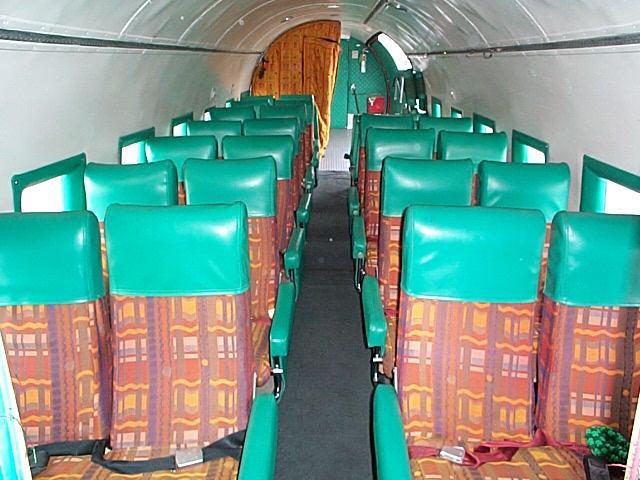
Throughout the week, the aircraft had performed admirably. The flight home that night was not to be, however. On the take-off run, the right engine failed to deliver full power, as we lifted off over a rock-strewn landscape. Graham made the decision to shut-down number two, and for the next ten minutes the aircraft held an altitude of two hundred feet. A "Pan-Pan" was called, picked up by a high-flying "Conair" Bird-dog pilot and relayed to Fort Simpson Tower. As Kenny Bews maintained altitude on the one good engine (with the temps rising notably), Graham came back to have a look at the engine. We discussed the sudden loss of power after take-off...there was no flame or smoke, and nothing had "fallen off".
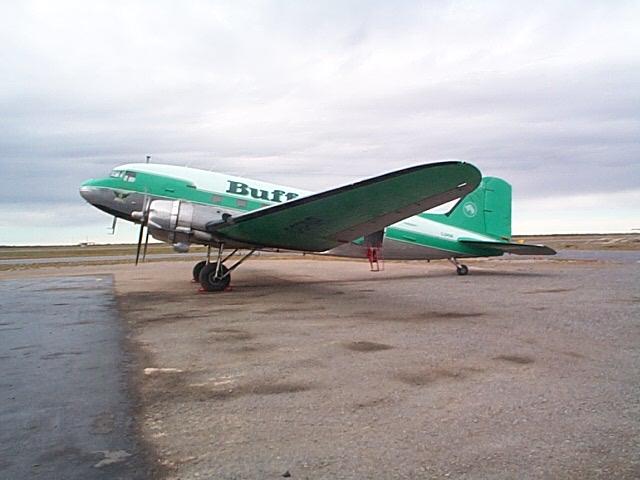
At least the wheels were "in the wells", and the cabin was empty of freight, but the aircraft would not climb beyond two hundred feet. With the Captain back at the controls, he eased the DC-3 out over the Lake, hugging the shoreline (in the event we lost the number one and had to ditch), and began lining up for the airstrip we had just left, minutes earlier. It was a very "tricky" approach, as a conventional DC-3 under "those" conditions would not remain airborne on one engine with the wheels down...if the wheels were "dropped" too soon, we wouldn't make it to the runway, now six miles distant. On one engine, the "travel" of the gear going down would be "delayed" considerably, and if the Captain and First Officer were "late" with the gear, we would find ourselves flying the length of the three thousand foot airstrip with the wheels half-way out of the wells, flaps at 45 degrees and would be left with slim chance of a successful "overshoot", on one engine and flying in outer air temperatures of 95 degrees.
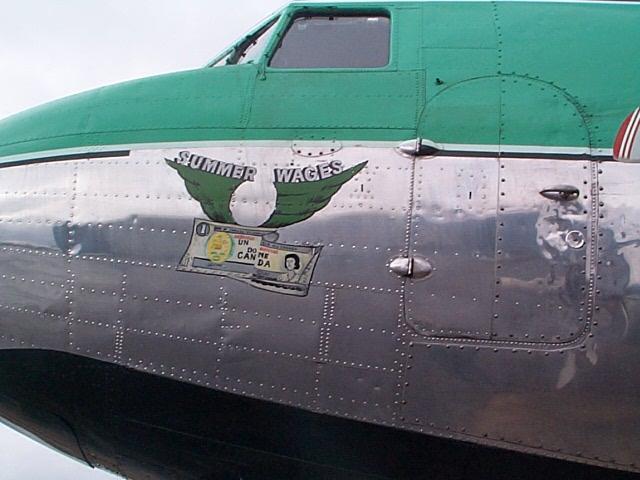
The approach and timing were perfect...Graham set the aircraft down one third of the length of the gravel runway, and promptly shut down the number one at the end of the runway. It was discovered that the governor cable on the front of the number two engine had "separated" on takeoff...there was nothing wrong with the R-1830 at all, beyond a governor cable-break. We were installed in a "Guest Cabin" in Trout Lake, after "putting the aircraft to bed", where we recounted the events of the last flight into the wee hours. Early the next morning, Buffalo's Owner, Joe McBryan, flew in with two engineers from Yellowknife in his twin Beechcraft; by mid-day we were in the air with "W I R" and winging our way home to Yellowknife, an hour and forty-five minutes to the northeast. Arriving back on the ground, it was "business as usual" and the "Trout Lake Holiday" came to an abrupt end, as we all departed on separate DC-3 flights to "the next destination"...and you can quote me on this! Darrell Knight, former-Commercial Pilot, Buffalo Airways, Northwest Territories, Canada. endtrans.
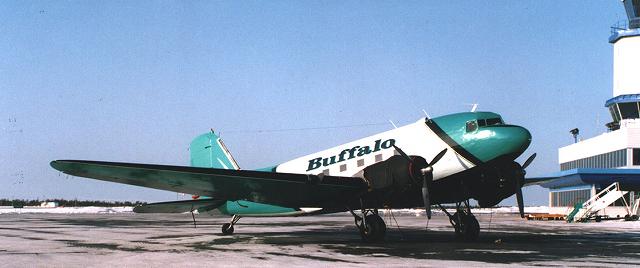
I was a Commercial Pilot at Buffalo Airways, (Yellowknife, Northwest Territories, Canada) during the "Koala Airlift" days of 1993 and 94. In September of 1993, our charters escalated dramatically to provide freight, fuel tanker and passenger service with DC-3s to the 1750 foot gravel strip at Lac de Gras, known to the Pilots as Koala Field. Buffalo Airways, owned by "Buffalo Joe" and Sharon McBryan of Hay River, was contracted to fly up to eighteen trips per day, into and during the deepest freeze of the winter of 93 - 94, with a daylight "window" of less than six hours. Temperatures often descended to minus-forty, after October, often with an added chill factor below that created by twenty-knot winds "whistling across Yellowknife Airport", off of the Great Slave Lake. At 06:00 each morning (three hours before daylight), we would have to load and "herman-nelson" our radials, to make the first seven aircraft ready for take-off, each morning. From the first week of September, we all worked every day, until we were given two days off at Christmas...and then came back "at it" just as hard, on the 27th of December. If a DC-3 was not in the air by 14:25 p.m. (local), we would have to leave the load on board, "tent" the engines, and install "in-car" heaters in the engine nacelles, in an attempt to maintain at least "0 degrees C" in the nacelles.
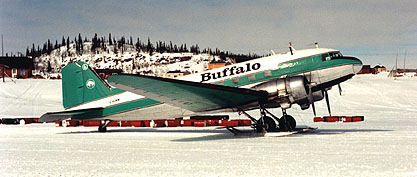
Due to the failing light on the barrens, each DC-3 had to arrive over Koala by 15:10 p.m. (local)... forty five minutes north of Yellowknife. Our reputation as an airline was, "we never fail to arrive, and we never bring a load home without delivery". The advent of the "GPS" navigation system made this "no idle boast". We hauled passengers in "W I R" and "W Z S"; "J K M", "L F R" and ""R O D" were flown as pure freighters, while "G H L" and "F A Y" were rigged out as flying fuel tankers, hauling many thousands of gallons of diesel into the Koala camp. Our regular "Sched" DC-3s, "C U E" and "P N R", were not used as such for the Koala Airlift flights. Of course, not every day was an"eighteen-trip" day to Koala...some days, we were only able to put in a few flights to the mine. We had no hangars for these aircraft, except if maintenance was required, and then the NWT Air Hangar would be utilized, providing that NWT Air's 737s or "stretch C-130 Herc" were not occupying the Hangar. Our DC-3s stood on the ramp, "naked" in the sub-zero murk...we had to work like men "driven", to start herman-nelsons, fork-lifts, ramp vehicles and then our DC-3s, after they had been loaded by the flight crews themselves. Captains, First Officers and all other Pilots loaded and unloaded their own aircraft, and no loading crews were available at the "Koala Field" to unload. These were twelve to eighteen hours per day of "bull-work", in sub-zero temperatures that, eventually, we came to "get used to".
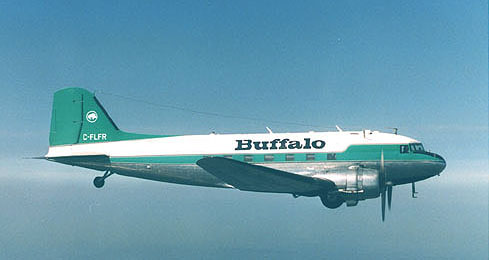
Each aircraft normally hauled 28 "pax", seven thousand pounds of freight - cargo - pipe - chain - caterpillar parts - steel beams, etc... or sixteen "55 US gallon" drums, lashed to the walls and floor of the aircraft with "herc-straps". Our take-off fuel load was normally "mains" and "thirties". We were "flying for the Diamonds", and all of us at Buffalo Airways knew that our effort was a history-making event. Initially, in the first few days of the Koala Airlift, none of us could believe the number of flights we were making to the mine, daily. We had the hottest, most experienced and best-paid Captains in the north flying in the Koala Airlift, to include Graham Thoburn, Jim Smith, Arnie Schreder, Chris Wells, Al Feindell, Murray Speers and Bob Burns. Our First Officers included Andrew Dzall, Kevin Woelk, Kenny Bews, Paul Misata, Lyndon Anderson, Scott Lippa and Marc Vanderaegen.
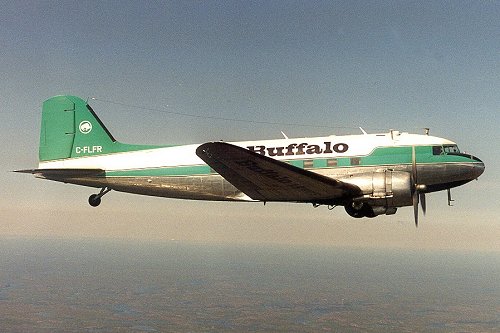
There were also a half dozen other Pilots, waiting for "PPC and the right-hand seat"; all of us were able to log a pile of "dual time", never-the-less. Buffalo Airways did not officially hire Flight Attendants...if passenger service was being flown, a third Pilot was sent on the trip, who had been previously checked out as the aircraft's "biscuit shooter" (all of the First Officers had to "graduate" through this phase, after "rolling drums" on the ramp or driving "fuel and freight" for their first half-year). The owner, "Buffalo Joe" McBryan, rarely flew to the mine, but usually Captained our "sched" service from Hay River and Fort Simpson, and kept a close eye on our progress, with Yellowknife-base Engineer Peter Austin orchestrating our flights and loads with maintenance requirements being the determining factor for "pulling" a DC-3 off-line. The airline's "world-wide" courier service was also on the go, with courier operations being orchestrated in Hay River and Yellowknife from Buffalo's Edmonton offices. Of over seven hundred flights in the initial stages of "The Koala Airlift", Buffalo Airways received the lion's share of the business, and our DC-3s were worked to the limit for BHP, our client.
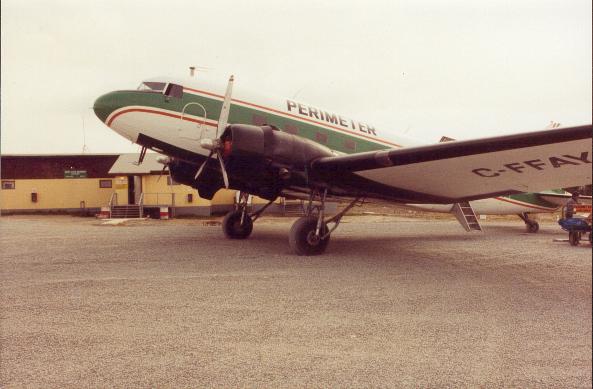
During this period, we also provided DC-4 "Northern Stores" flights to Fort Norman and Norman Wells, each Wednesday morning...which included loading 20,000 lbs. of food-freight, most of it perishable... with a fork-lift and a Johnny-Bar and a pallet-jack, and with "herman-nelsons" thawing out four Pratt & Whitney R2000 Radial engines on a freezing tarmac. Often, the DC-4 was not in the air until noon, despite loading and "hermaning" commencing at 05:30 a.m. (local). On these trips we always sent an Engineer along; we would return ten hours later. Our morale was second to none; our trust in our aircraft was never in question and our engineers always seemed to be able to "deliver the goods", when something broke. No one dared "get sick", in these long months of daily work, and no "days off" were expected or asked for. Only men flew with Buffalo during the Koala Airlift...the work involved was not unlike running a non-stop "marathon", except for our time in the air on the short flight to and from Koala Field.
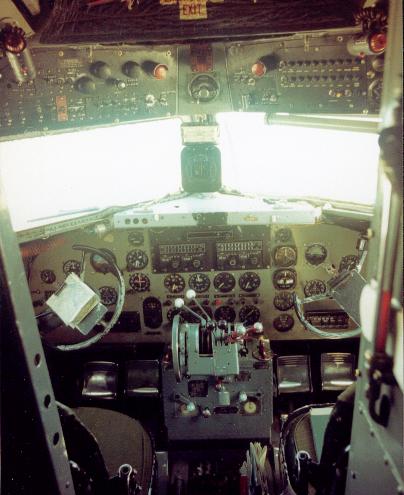
By February, with the opening of the ice-road to Lac de Gras, the Koala Airlift ended. For Buffalo, an amazing six months of non-stop "non mishap" flying had finished in one phase, however, we continued to fly on "urgency load" flights to Koala Field (primarily fuel tanker flights) in the following weeks after the opening of the ice-road. The "pay-off" for a half-year of extreme hard work came short months later...with the DC-3 "J K M", and "crewed" by Graham Thoburn, Andrew Dzall and myself, we flew eight yellow drums containing "sample number one" off of Koala Field, bound for Yellowknife and beyond to Edmonton. In this manner, Canada's first diamond mine was eventually opened...and Buffalo Airways DC-3s and the crews who "manned" them, were there from the beginning...Darrell Knight. ex-Buffalo Airways Pilot.
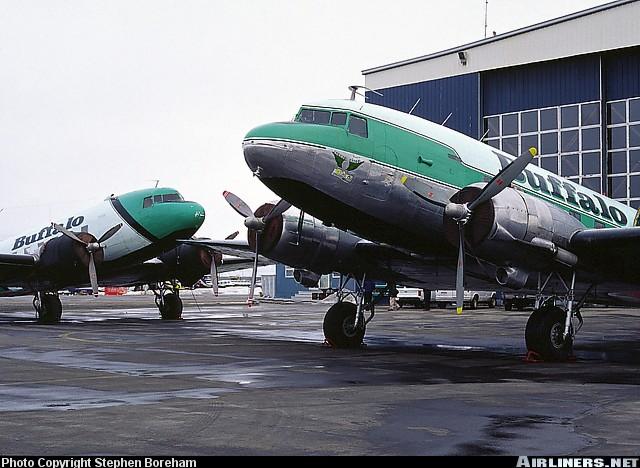
C-GWIR
| Construction Number | 9371 |
| Plant Number | 42-23509 |
One of the more ‘traveled’ DC-3s is C-GWIR. Delivered to the 8th Air Force on April 13, 1943, it remained there until March 1960. At this point, she moved to the French Air Force, which she was a member of until 1963. Over the next 12 years, this airplane would be based in many different parts of the world. C-GWIR moved to Algiers, Tucson AZ, Calgary AB, Winnipeg MB, and finally the NWT. She was a valuable asset to NWT Air until 1981 when she moved to Buffalo Airways. To this day, most of the markings in this aircraft are still in its original language - French.
| Date | Action | Operator | Location |
| 1942 | Manufactured | - | - |
| Apr.13/43 | Delivered | 8th Air Force | - |
| May 29/43 | Registered | - | Oran |
| Mar. 12/44 | Registered | 8th Air Force | - |
| - | Registered - OK-VAV | Min Dopravny | Czechoslovakia |
| Mar. 01/60 | Registered - 23509 | French Air Force | France |
| Feb. 1962 | - | French Air Force | France |
| Mar. 1962 | - | French Air Force | France |
| Jan. 1963 | - | French Air Force | France |
| Apr. 1964 | Registered - FRAJN | - | France |
| Aug. 1964 | - | - | - |
| Jun. 1966 | Registered - FRAJR | - | France |
| Jun. 1968 | Registered - FTEFK | - | France |
| - | - | Air Attache | Algiers |
| - | Registered - F-WSGY | - | France |
| - | - | Rousseau Aviation | France |
| Apr. 13/74 | Registered/Exported-N18262 | Stroul | Tuscon, AZ, USA |
| Apr. 03/75 | Registered - C-GWIR | Carruthers | Calgary, AB, Canada |
| 1975 | Leased | Aero Trades Western Ltd. | Winnipeg, MB, Canada |
| 1976 | Returned | Carruthers et al | Calgary, AB, Canada |
| 1977 | Leased | Lambair Ltd. | Winnipeg, MB, Canada |
| 1977 | Returned | Carruthers et al | Calgary, AB, Canada |
| 1978 | Leased | Alberta Northern Airlines | AB, Canada |
| Oct. 26/78 | Delivered | Alberta Northern Leasing | AB, Canada |
| 1980 | Leased | Northwest Territorial Airways | Yellowknife, NT, Canada |
| Dec. 1981 | Bought / Registered | Buffalo Airways | Hay River, NT, Canada |
| Apr. 1982 | Leased | Northwest Territorial Airways | Yellowknife, NT, Canada |
| - | Returned | Buffalo Airways | Hay River, NT, Canada |
C-GWZS
| Construction Number | 12327 |
| Plant Number | 42-92518 |
| Date | Action | Operator | Location |
| 1942 | Manufactured | - | - |
| Jan. 14/44 | Delivered | Royal Air Force | Canada |
| Feb. 0544 | Registered | KG330 - Royal Air Force | Montreal, QC, Canada |
| Feb. 23/45 | Transported | Royal Air Force | United Kingdom |
| Dec. 09/45 | Allocated | 437 Squadron - RAF | United Kingdom |
| Apr. 22/46 | Registered | Canadian Government | Canada |
| Jul. 20/46 | Allocated | Royal Canadian Air Force | Canada |
| May 07/76 | Registered | Can-Air Services Ltd. | Edmonton, AB, Canada |
| 1979 | Leased | Contact Airways | Canada |
| Dec. 1979 | Bought | Buffalo Airways | Fort Smith, NT, Canada |
| Apr. 25/80 | Delivered | Northwest Territorial | Yellowknife, NT, Canada |
| - | Registered | Buffalo Airways | Hay River, NT, Canada |
C-GPNR
The most commonly used DC-3 for scheduled freight service is, C-GPNR entered active service on May 17, 1944. She started out as a member of the Royal Air Force and flew in the United Kingdom and Middle East until June 1946. At this point, the aircraft came to Canada to fly for the Royal Canadian Air Force. In October of 1980 Buffalo Airways received this pristine aircraft and put her back to work in the NWT.
| Construction Number | 13333 |
| Plant Number | 42-93423 |
| Date | Action | Operator | Location |
| 1942 | Manufactured | - | - |
| May 17/44 | Delivered | Royal Air Force | Canada |
| May 25/44 | Allocated | KG602 - Royal Air Force | Montreal, QC, Canada |
| May 30/44 | Transported | Royal Air Force | United Kingdom |
| Jul. 05/44 | Allocated | 575 Squadron - RAF | United Kingdom |
| Oct. 11/45 | Allocated | 512 Squadron - RAF | Middle East |
| Apr. 04/46 | Allocated | 437 Squadron - RAF | United Kingdom |
| Jun. 16/46 | Registered | Canadian Government | Canada |
| Sept. 09/46 | Allocated | Royal Canadian Air Force | Canada |
| 1952 | Reg. as 'VCDHJ' | - | - |
| - | Registered | 429 Squadron - RCAF | Canada |
| Mar. 1975 | Stored | - | Saskatoon, SK, Canada |
| Oct. 1980 | Bought / Registered | Buffalo Airways | Hay River, NT, Canada |
C-GJKM
| Construction Number | 13580 |
| Plant Number | 42-93645 |
| Date | Action | Operator | Location |
| 1942 | Manufactured | - | - |
| Jun. 11/44 | Delivered | Royal Air Force | Canada |
| July 08/44 | Registered | Royal Air Force | Montreal, QC, Canada |
| Dec. 16/44 | Allocated | 144 Wing Royal Air Force | Canada |
| Jun. 11/45 | Transported | Royal Air Force | United Kingdom |
| Sept. 13/45 | Allocated | 435 / 436 Squadron - RAF | United Kingdom |
| Mar. 17/46 | Allocated | 435 Squadron - RAF | United Kingdom |
| Apr. 08/46 | Transported | - | Canada |
| Jul. 02/46 | Registered | Royal Canadian Air Force | Canada |
| 1952 | Reg. as 'VCGSL' | - | - |
| 1976 | Stored | - | Saskatoon, SK, Canada |
| Oct. 1980 | Bought / Registered | Buffalo Airways | Hay River, NT, Canada |
C-FLFR
C-FLFR was delivered to the Royal Air Force on April 29, 1944. It flew in the United Kingdom until March 1946 when it was moved to Canada to become a member of the Royal Canadian Air Force. From 1958 to 1964 she was an Air Transport for the United Nations, and was then purchased, owned and operated by various companies in Eastern Canada. C-FLFR is now a valuable member of the Buffalo Airways team and is commonly put on skis for travel into the snow-covered arctic.
| Construction Number | 13155 |
| Plant Number | 42-93263 |
| Date | Action | Operator | Location |
| 1942 | Manufactured | - | - |
| Apr. 29/44 | Delivered | Royal Air Force | Canada |
| May 11/44 | Allocated | KG563 - RAF | Canada |
| May 20/44 | Delivered | Royal Air Force | United Kingdom |
| Jun. 12/44 | Allocated | 48 Squadron - RAF | United Kingdom |
| Mar. 17/46 | Allocated | 435 / 436 Squadron - RAF | United Kingdom |
| Apr. 23/46 | Registered | Canadian Government | Canada |
| Oct. 01/46 | Allocated | RCAF | Canada |
| 1958 - 1964 | Allocated | 115 Air Transport Unit, UN | United Nations, Various |
| Dec. 09/69 | Registered - CF-LFR | St. Felicien Air Services | St. Felcien, QC, Canada |
| 1977 | Registered | Survair Ltd. | Canada |
| 1978 | Registered | Bradley Air Services | Carp, ON, Canada |
| - | Registered | Buffalo Airways | Hay River, NT, Canada |
C-FCUE
C-FCUE was built by the Douglas Aircraft Company in Santa Monica, California, in April of 1942. She was delivered to the United States Air Force as a “C-47A” in 1944 and flew in military roles for just under three years. At this point, she was sold to Canadian Pacific Air Lines, through the Reconstruction Finance Corp. and the Charles Babb Co., to begin her career transporting passengers across Western and Northern Canada. This DC-3 was the first aircraft to land on the runway at what is now the Yellowknife Airport. In February 1956, Transport Canada purchased the airplane and flew it for an average of 700 hours per year right up until it was retired on October 9, 1990. Buffalo Airways then purchased this beautiful machine in 1992 and has put her back into service as a graceful addition to the fleet.
| Construction Number | 12983 |
| Plant Number | 42-93108 |
| Date | Action | Operator | Location |
| 1942 | Manufactured | - | Santa Monica, CA, USA |
| Apr. 10/44 | Delivered | USAF | USA |
| May 09/44 | Transported | USAF | N. Africa |
| Aug. 19/45 | Registered | - | USA |
| Aug. 23/46 | Registered | Reconstruction Finance Corp. | USA |
| - | Registered | Charles Babb Co. | Glendale, CA, USA |
| Jan. 17/47 | Bought | Canadian Pacific Airlines | Canada |
| Feb. 13/56 | Registered | Department of Transport | Ottawa, ON, Canada |
| - | Registered | Buffalo Airways | Hay River, NT, Canada |
C-FDTH
| Construction Number | 12591 |
| Plant Number | 42-92755 |
| Date | Action | Operator | Location |
| 1942 | Manufactured | - | - |
| Feb. 22/44 | Delivered | Royal Canadian Air Force | Canada |
| - | - | - | Patricia Bay, BC, Canada |
| Apr. 24/44 | Stored | - | Canada |
| Sept. 14/46 | Registered - CF-TEB | Trans Canada | Canada |
| Jan. 11/61 | Registered | Department of Transport | Canada |
| - | Bought / Registered | Buffalo Airways | Hay River, NT, Canada |
C-FDTB
| Construction Number | 12597 |
| Plant Number | 42-92761 |
| Date | Action | Operator | Location |
| 1942 | Manufactured | - | - |
| Feb. 25/44 | Delivered | Royal Canadian Air Force | Canada |
| Mar. 10/44 | Allocated | KG485 - RCAF | Canada |
| Apr. 01/44 | - | - | - |
| May 16/46 | Registered - CF-TEC | Trans Canada | Canada |
| Mar. 19/58 | Registered - CF-DTB | Department of Transport | Canada |
| - | Bought / Registered | Buffalo Airways | Hay River, NT, Canada |
C-FFAY
| Construction Number | 4785 |
| Plant Number | 41-18624 |
| Date | Action | Operator | Location |
| 1941 | Manufactured | - | USA |
| Oct. 30/42 | Delivery | - | USA |
| Sept. 21/45 | Registered | Reconstruction Finance Corp. | USA |
| Dec. 1953 | Registered - NC57540 | Cia Bananera de Costa Rica | San Jose, Costa Rica |
| Apr. 12/57 | Registered - YV-C-AVY | Avensa | Venezuela |
| - | Registered - YV-C-LBE | LEBCA | Venezuela |
| Nov. 04/68 | Registered - YV-C-TCB | Transcarga | Vanezuela |
| Sept. 1971 | Registered - N47218 | Aero American Corp. | USA |
| Apr. 25/72 | Bought | Astro Aviation | Red Deer, AB, Canada |
| Nov. 29/72 | Registered | Sterling Air Services Ltd. | Red Deer, AB, Canada |
| Jul. 29/73 | Registered | Lambair Ltd. | The Pas, MB, Canada |
| Nov. 1981 | Delivered | Perimeter Airlines | Winnipeg, MB, Canada |
| - | Bought / Registered | Buffalo Airways | Hay River, NT, Canada |
